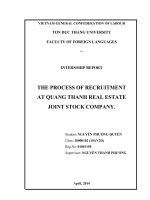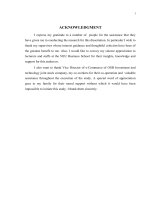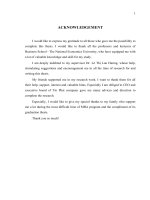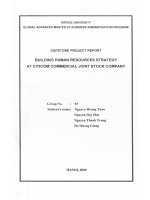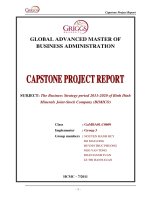Poor accounts receivable collection at binh minh plastics joint stock company
Bạn đang xem bản rút gọn của tài liệu. Xem và tải ngay bản đầy đủ của tài liệu tại đây (805.57 KB, 58 trang )
UNIVERSITY OF ECONOMIC HO CHI MINH CITY
International School of Business
-------------------------------
PHAN THI THANH TRAM
POOR ACCOUNTS RECEIVABLE
COLLECTION AT BINH MINH
PLASTICS JOINT STOCK COMPANY
MASTER OF BUSINESS ADMINISTRATION
Ho Chi Minh City - 2017
UNIVERSITY OF ECONOMIC HO CHI MINH CITY
International School of Business
-------------------------------
PHAN THI THANH TRAM
POOR ACCOUNTS RECEIVABLE
COLLECTION AT BINH MINH
PLASTICS JOINT STOCK COMPANY
MASTER OF BUSINESS ADMINISTRATION
SUPERVISOR: Prof. Pham Phu Quoc
Ho Chi Minh City - 2017
SUPERVISOR’S REPORT ON THE FINAL THESIS SUBMITTED
FOR DEGREE OF MASTER of BUSINESSADMINISTRATION
The final thesis title: POOR ACCOUNTS RECEIVABLE COLLECTION
AT BINH MINH PLASTICS JOINT STOCK COMPANY
Student Name: PHAN THI THANH TRAM
Supervisor: Prof. Pham Phu Quoc
1. General comments:
Remarks on the student’s attitude:
……………………………………………………………………………
……………………………………………………………………………
Remarks on the assignment’s academic quality:
……………………………………………………………………………
……………………………………………………………………………
2. Overall assessment:
Meet requirement for submitting
Not meet requirement for submitting
3. Other remarks:
Did the student follow the report schedule?
Yes
No
The Turnitin plagiarism percentage:
Supervisor’s signature
Other………………………….
CONTENTS
EXECUTIVE SUMMARY ...........................................................................................1
CHAPTER 1: INTRODUCTION ................................................................................2
1. Company background............................................................................................2
2. Company symptom................................................................................................4
CHAPTER 2: PROBLEM IDENTIFICATION .........................................................7
2.1 Potential problems ..................................................................................................7
2.2 The central problem .............................................................................................12
CHAPTER 3: CAUSE VALIDATION ......................................................................15
3.1 Possible causes .....................................................................................................15
3.2 Central cause validation .......................................................................................17
CHAPTER 4: SOLUTIONS .......................................................................................19
4.1 Possible solutions .................................................................................................19
4.2 Suitable solutions .................................................................................................21
CHAPTER 5: ACTION PLANS ................................................................................23
CHAPTER 6: CONCLUSION ...................................................................................27
APPENDICES ..............................................................................................................28
REFERENCES ............................................................................................................51
LIST OF TABLES
Table 1: Days sales outstanding of Binh Minh Plastics
Table 2: Analysis the possible solutions of Binh Minh Plastics
Table 3: Binh Minh Plastics Joint Stock Company Action Plans
LIST OF FIGURES
Figure 1.1: Binh Minh Plastics organizational structure
Figure 1.2: Days sales outstanding of BMP, NTP and industry
Figure 2.1: Aging of BMP’s accounts receivable in 2016
Figure 2.2: Overdue debt ratio of BMP in 2016
Figure 2.3: Initial cause and effect map
Figure 3: Final cause and effect map
EXECUTIVE SUMMARY
Days sales outstanding of Binh Minh Plastics Joint Stock Company in the period 2013
- 2016 tends to increase and be higher than competitors and the industry which shows
signs of bad working capital situation tied up in accounts receivable. In addition, there
is an increase in the risk of bad debts if it can not be recovered, and increased costs
associated with receivables monitoring and receivables collection. This thesis aimed at
investigating practices adopted by Binh Minh Plastics in the management of accounts
receivable to find out the central problem to make high days sales outstanding over the
years and to recommend ways to solve this problem.
Follow-up investigations revealed three possible problems: ineffective trade credit
policy, poor credit collection and late payment from customer. In particular, the
problem of poor credit collection is defined as the central problem, which has the great
influence on the increase high days sales outstanding and can be solved in the present
situation.
After considering all the aspects that affect the central problem, the thesis has found
the main reason caused the poor credit collection is poor credit collection policy.
Besides that, the thesis finds and proposes alternatives solution and practices for
effective credit collection policy to improve this issue. Binh Minh Plastics should
improve a credit collection policy by setting out the procedures and practices to be
used by the company to collect overdue or delinquent accounts receivable. In addition,
the company should automate their electronic invoicing system to cut down on the
time taken to present invoices to customers.
1
CHAPTER 1: INTRODUCTION
1. Company background
Industry overview
Construction plastics - real estate and warming construction are major support for the
growth of the sector. The plastic construction market occupies only 18.2% of the total
plastics industry but grows rapidly, to 15 - 20% per year. Currently, there are 180
enterprises operating in the two sectors: construction plastic pipes and building
materials. According to the BMI predicted the average real growth of Vietnam's
infrastructure will be 6% per annum in 2016 - 2024. The demand for plastic pipes is
increasing, creating a momentum for the growth of the construction industry in the
future.
Market share and competitors
Construction plastics are mainly domestically under more severe competitive pressure.
Binh Minh Plastics (BMP) leads the market in the South with a market share of nearly
50% and 25% of the national market share. While Tien Phong Plastics (NTP) holds
about 60% of the northern plastic pipe market share and 29% of the national market
share. However, Binh Minh Plastics recently faced market penetration by competitors
such as Hoa Sen, Europipe and Tan A Dai Thanh…As you can see, competition in the
construction plastics market is becoming much more intense and market share slice
may have to be broken up for these new businesses. The domestic plastic industry is
still dominant thanks to its large scale and strong brand. So if BMP are no reasonable
policies to adapt to the competitive market, market share will be affected.
Company background
Binh Minh Plastic, which was established on November 16th 1977, is a leading
company in Vietnam manufacturing and trading in plastic pipes and fittings for water
supply and drainage, telecommunication, electricity, industrial and civil construction.
The Company has four factories in Ho Chi Minh City, Binh Duong, Long An and
2
Hung Yen provinces with capacity of 150,000 tons/year, entirely meeting domestic
demands and preparing for international exports in the future.
On the other hand, Binh Minh Plastics has applied sale model of distribution system
through stores. The store systems of the company include main stores and branch
stores. Currently, the company has a total of nearly 1,500 stores across the country
ensuring supply of goods quickly and timely at demands of customers. In addition, the
company also has engaged in key national projects with government as the role of
supplier for the water supply and construction buildings.
Company name: CÔNG TY CỔ PHẦN NHỰA BÌNH MINH
English name: BINH MINH PLASTICS JOINT - STOCK COMPANY
Abbreviation: BMPLASCO
Business registration certificate and tax code: 0301464823
Charter capital: VND 454,784,800,000
Head office: 240 Hau Giang, Ward 9, District 6, HCMC
Telephone: (84-28) 39 690 973
Fax: (84-28) 39 606 814
Website: www.binhminhplastic.com.vn
Security code: BMP
Besides, the implementation of commitments and sustainable management solutions
such as taking care and developing eco-friendly resources, utilizing energy
consumption, improving internal HR policies, investing in high technology, and caring
for the working environment improvement in the past years had the positive effects to
the business result of the company.
3
The internal structure of the company is showed in the graphic as follow:
Figure 1.1: Binh Minh Plastics organizational structure
(Source: BMP’s annual report in 2016)
2. Company symptom
After deep analysed the company's annual report and investigated the financial ratios
in the period from 2013 to 2016, the symptom of the problems had been revealed is
high in days sales outstanding (DSO) during the period of four years.
Table 1: Days sales outstanding of Binh Minh Plastics
Item
Net credit sales (1)
Average Accounts Receivable (VND) (2)
Receivable Turnover Ratio (Round) (3) =(1)/(2)
Days sales outstanding (4)=365/(3)
%change in DSO comparision with the previous year
Year
2013
1,276,043,760,135
297,203,614,064
4.29
85
0%
2014
1,119,039,841,368
294,615,362,613
3.80
96
13%
2015
2016
1,068,879,615,018 1,033,005,969,909
322,413,279,111
405,097,125,465
3.32
2.55
110
143
15%
30%
(Source: BMP’s financial data 2013-2016)
4
In order to increase revenue and diversify its distribution channels, beside its
traditional distribution system, forced the company to apply the policy of lenient credit
policy. So, the days sales outstanding of BMP tend to increase over the years, rising
sharply by 2016, with 30% higher than in 2015 and 68% higher than in 2013. In 2013,
the days sales outstanding is 85 days, the trend is to increase gradually over the years
2014, 2015, and especially in 2016 with 143 days. Meanwhile, the credit term of the
company is from 7 to 90 days. It means that in 2016, in BMP, days sales outstanding is
higher than credit term for collection customers 53 days (compared to the highest
level), equivalent more than 59%. This shows a symptom of days sales outstanding of
accounts receivable is much higher than the previous years its and the credit term for
customers.
Days sales outstanding of BMP, NTP and industry
160
140
120
100
80
BMP
60
NTP
40
Industry
20
-
2013
2014
2015
2016
BMP
85
96
110
143
NTP
68
65
71
75
Industry
76
79
86
98
Figure 1.2: Days sales outstanding of BMP, NTP and industry
(Source: BMP, NTP’s Balance Sheet 2013-2016)
In comparision to the construction plastics and the formidable competitor NTP, BMP’s
days sales outstanding are the highest. While NTP's days sales outstanding is always
lower than that of the industry, BMP’s days sales outstanding is always higher than the
industry. Comparing to the ratio of rival NTP, the days sales outstanding of BMP is
nearly double in 2016, nearly 1.5 times compared with the industry. It is notable that in
5
2016, it increased sharply while NTP and the industry still controlled the growth rate.
This is a significant gap between BMP’s days sales outstanding and the others. The
comparisions with the industry and NTP, it shows a bad sign for the ineffective in
accounts receivable from customers of BMP in 2013-2016 periods.
Conducting interviews with members of BMP, this situation has made the manager of
BMP try to research a best way to reduce days sales outstanding as soon as possible.
The increase in the number of days sales outstanding has a great impact on the
business, financial and profits of BMP. A large amount of money is tied up in the
accounts receivable, which increases the cost of capital, increases the cost of managing
receivables and, in particular, the high risk of bad debts and not recovering the debts.
According to Mr. Hoang Ngan, the Chief Executive Officer of BMP, “We are facing
very trouble challengings, one of those is high days sales outstanding from trade
receivables. Days sales outstanding tend to increase over the years as working capital
flow decrease, the risk of bad debts increases, attached is the cost of receivables
collection increases”. This great trouble is recognized as the symptom that the central
problem and potential causes need to be found and analyzed to solve this situation.
6
CHAPTER 2: PROBLEM IDENTIFICATION
2.1 Potential problems
From the symptom of high days sales outstanding, combining literature and evidence
from in-depth interviews with professional staffs, management personel, Board of
Management of the company, there are three potential problems that the company is
facing following:
- Ineffective trade credit policy
- Poor credit collection
- Late payment from customer
Ineffective trade credit policy
A trade credit is an agreement where a customer can purchase goods on account
(without paying cash), paying the supplier at a later date. Credit policy is important for
three main reasons. First, it has a large impact on sales, secondly, it affects the amount
of funds tied up in receivables and lastly it affects bad debts (1). Pandey (2) stated that
credit policy is determined in the manner as the combination of such terms as credit
period, credit standards, collection period, cash discounts and cash terms. Accroding to
Kalunda, Nduku & Kabiru (3), a lenient credit policy tends to provide credit to
customers under very liberal terms and standards such that credit is granted for longer
periods even for creditworthy customers is not well known.
With the strategy of developing the distribution system, expanding the market share,
and to compete with other rivals, BMP has applied lenient credit policy. However, the
issue of ineffective trade credit policy has been identified as attention problem, which
increase significantly the days sales outstanding. Conducting interviews with to Mr.
Ngan, Chief Executive Officer of BMP, “The company has to deal with big risk of
long time debt and difficult to recover situation in accounts receivable from
customers”. According Mr. Viet, the Chief Accountant, “an amount of working capital
tied up in this account for long time”. This is a sign that the company is having
difficulty in implement sales on credit. “The company applies long credit term to
7
guests. For those stores in the province the credit term is longer than stores in Ho Chi
Minh city, with guests up to 60 days. As for project clients, depending on the
relationship that the sales department proposes to approve for up to 90 days”. This
shows that credit policy is not effective with current company situation.
According to Ms Nga, sales manager, “BMP’s customers have two major customer
groups that are distribution store system and water supply and drainage and
construction companies. In addition to maintain the distribution system as the
foundation, BMP implemented a strategy to expand its customer base to the project
through the lenient credit policy”. According to Mr. Thanh, the receivables accountant,
“for groups of customers of water supply and constructions who purchased debt by
trust and relationship, the company will accept the limit of sale of debt and time debt
as approved by the Chief Executive Officer. Different customers will be issued
different credit term and credit limit”. The noteworthy thing here is, “Although
customers of water supply or constructions have overdue debt, the sale of debt will
continue with the approval of the Chief Executive Officer and the decentralized.
Because of the relationship with guests, most credit sales will be done despite having
overdue debts or overdue large amounts or long periods of time”. BMP has not yet
developed a strong credit standard for this group on the company's debt finance
appraisal to set a limit on the amount of owed. This lenient credit policy can attract
customers but also lead to non-payment due to weak customer finance.
Mr. Viet, the Chief Accountant, revealed that “To ensure the quality of receivables of
the stores system, BMP secured by mortgages such as deposits, houses, land, etc.,
following the customer receivables control regulations, so as to minimize the risk of
non-recovery receivables. However, for project clients, BMP can only assess
contractors's repayment ability based on reputation, capacity of contractors and
investors, etc. to make decisions for purchase credit. This trade off between risk and
profitability in business makes accounts receivable increased over the years from 2014
to now, expressed most clearly by the days sales outsanding increased dramatically in
2016.”
8
According to Maria Groczynska (4), particularly, if the DSO exceeds a company’s
credit terms, this may indicate that a company is ineffective in collecting its credit
sales or is granting credit to marginal customers. It is true when now BMP company is
suffering the high DSO status that caused by inefffective credit policy when stuck in
ineffective accounts receivable. It imposes high risk into bad debts, doubtful debts.
Poor credit collection
Poor credit collection has led to an increase in outstanding receivables, including
overdue receivables. According to the figure of aging of BMP's accounts receivable in
2016 (Figure 2.1), the majority of accounts receivable are in the range of 45 days to 90
days (accounting for 44% ), the range of 6 months to 12 months (accounting for 37% )
and over 2 years - consider as default (accounting for 14%). While, the credit terms
usually range from 7 to 90 days. It shows that, otherwise ineffective credit policy
problem has made increasing many outstanding receivables that affects high days sales
oustandings, the remaining receivables is the problem of ineffective credit collection.
The remaining 55% of the outstanding receivables are over 90 days of maturity,
including restructured debts or overdue debts with the majority is from 6 months to 1
year (37%) and default debts (14%).
Aging of BMP's accounts receivable in 2016
1%
1%
14%
0 -45 days
45 days - 3 months
44%
3 months - 6 months
6 months - 12 months
1 years - 2 years
37%
over 2 years - consider as default
3%
Figure 2.1: Aging of BMP’s accounts receivable in 2016
(Source: Accounts receivable of BMP in 2016)
9
Overdue debt ratio of BMP in 2016
Debt in the term
14%
0.2%
Overdue debts in 0 -45 days
Overdue debts in 45 days - 3 months
Overdue debts in 3 months - 6 months
24.5%
58%
Overdue debts in 6 months - 12 months
Overdue debts in 1 years - 2 years
1%
Overdue debts in over 2 years - consider
as default
2%
0.3%
Figure 2.2: Overdue debt ratio of BMP in 2016
(Source: Accounts receivable of BMP in 2016)
Mr Thanh, the receivables accountant, “There is no effective cooperation between
sales staff and accountant. Salespeople are not concerned about the due or past due
receivables. Therefore, they often ask for approval of the sale even if the customers are
overdue receivables and the receivables time is too long”. The views between the
business and accounting department are not consistent due to unclear and inefficient
collection policy. The combination of sales and accounting departments in the
collection receivables of customers are more constrained. Meanwhile, “When
receivables are due or overdue, because of customer relationships, the receivables
accountant does not notify directly to the customer but through the sales staff. These
employees will contact customers to request for repayment of old receivables to be can
purchase”. Mis Lan, sale staff, “With the approval of the director, and more of
important customers who have a special relationship with BMP, so these orders can
not sold to customers. Receivables management is the work of accounting, also about
sales only sells goods when the approval of the director”.
According to Mr Thanh, the receivables accountant, “the receivables collection policy
is not clear, because the customer relationship, when the overdue receivables arisen,
10
receivables accountant does not call or send a written reminder to customers. That's
just, at the end of each month, the debt notification to customer”. “The collection of
money is also through intermediaries is sale department, when the need to notify the
customer about receivable is sent through the sales to transfer debt notification to
guests”. Company is not set up debt collection rules, resulting in many overdue debts
but the company still has no way to collect more money.
For any overdue or delinquent accounts, a reminder form, letter, telephone call or visit
may facilitate customer payment. At minimum, the company should generally suspend
further sales until the delinquent account is brought current. Should these actions fail
to generate customer payment, it may be necessary to negotiate with the customer for
past-due amounts (5).
Late payment from customer
Although trade credit has played an important role in business’s growth and profit
goal, there is still a possibility that a regular trade credit develops into a delayed
payment and forces the creditor to undertake certain (usually undesired) economic
actions. The most critical ones are a consequence of the fact that problems with
receivables are usually the reason for accumulation of overdue payments and can
finally lead to insolvency (6). Additionally, delays in receivables influence investment
in plant, inventories, machinery and other assets. So the problem of delayed customer
payments has been identified as noteworthy issue, which might not only influence the
market decisions of enterprises but also affect market structure by spreading
differently among different kinds of enterprises.
According to Mr. Thanh, the receivables accountant, “project customer and water
supply customers delayed their debt for longer time” and “there are bad debts from
customer agents who can not afford to pay”. So it accounted an amount of working
capital locked up in this accounts receivable.
From a macroeconomic point of view, the issue of late payment will be influenced by
the economic conditions, the development of the financial system. Garcia et al. (7)
11
states that level of accounts receivable is affected by the economic situation. Credit
collections depend on the industry (8), and effects of negative macroeconomic shocks
(9). In a worsening economic and market conditions, the ability to generate cash from
a company's operations decreases. As a result, some customers are unable to pay their
debts on time and postpone payment, causing the company increases their receivables.
Besides, there is more risky when the customer goes bankrupt.
According to Mr. Viet, the chief accountant, “In the economic and market conditions
in the plastic industry is gradually recovering. Construction companies have great
demand in this industry but the ability to generate money from the operation of
companies is very long, due to project completed by each progress. As a result, some
customers can not pay their debts on time and postpone the payment to increase the
company's receivables”. Mr. Thanh, the receivables accountant, “They only pay when
handing over the works to the investor, which is often late in comparison with the
payment time”. Large amount of accounts receivable became doubtful debts due to
customers lose their ability to pay, or bankruptcy.
2.2 The central problem
After investigating some of the financial ratios and interviewing all the responsible
members of the company, there are three problems are analyzed and identified as the
barriers lead high days sales oustanding in BMP in the period 2013 - 2016. Ineffective
credit policy makes the days sales outstanding of receivable increasing due to long
credit period as long credit collection time. Adding to that is low credit standards that
lead to companies not properly filtering out customers who are not qualified to sell
credit. This has made the days sales outstanding tend to increase over the years. But in
general, in terms of current business conditions, in order to maintain and expand
market share, the company takes risks from this policy to attract customers. Therefore,
this is not a central issue to address. As for customers paying late, through analysis and
understanding, this is the problem comes from the economic difficulties. Due to
difficult business conditions, the customers did not pay on time or these were the debts
12
of companies unable to pay, went bankrupt. Therefore, this is a problem outside the
enterprise so solving this problem is hardly feasible.
The problem of poor credit collection that great impact on the increase in receivables,
leading to high days sales outstanding in BMP. In addition, with the limited resources
do not allow solving all the problems at the time. Therefore, the problem of poor credit
collection is a central problem that is not only ensures to reduce days sales outstanding
but also ensures control of business operations. Through investigation, the cause of the
increase in receivables is higher due to the collecttion of poor receivables. The
company has no clear receivables collection policy, no departmental cooperation and
unsuitable receivables enforcement policy has made bad credit collection. This is an
issue that needs to be addressed as receivales collection is an important task for
businesses to quickly recover their cash inflows.
Based on the above developing, the following initial cause and effect tree has been
developed:
13
Low credit standards
Ineffective credit
policy
Long credit terms
Poor credit collection
policy
Symptom
High days
sales
outstanding
Central problem
Poor credit collection
Ineffective
coordination between
accounting and sale
department
Ineffective overdue
debt penalty
Figure 2.3: Initial cause and effect map
Late payment from
customer
Difficult economic
conditions
14
CHAPTER 3: CAUSE VALIDATION
3.1 Possible causes
To find out the potential cause this problem, the theory combined with the deep
interview is conducted with the Gerneral Manager, Chief Accountant, the receivables
accountant and some employees who are working in Binh Minh Plastics. There are
four potential causes for the poor credit collection problem in accounts receivable:
Poor credit collection policy
Receivables collection policies are the procedures a company uses to collect overdue
or delinquent accounts receivables. A company must determine what its purchasing
policy is and how it will be implemented. Just like credit standards and credit terms,
the approach may be a function of industry and competitive environment (5).
According Brigham et al (1), a company can improve cash flow by reducing days sales
outstanding (DSO) achieved by training customers to pay on time. This requires
constant attention and monitoring. Company should be solid, but excessive pressure
can lead to profitable business customers to do business elsewhere. Thus, the costs and
benefits of different collection policies must be balanced.
According to Mr. Thanh, the receivables accountant, said that “BMP has poor
collection policy”. “Due to the customer relationship, when the maturity date of the
company does not send documents or carry out the notification of debt due to
customers but only waiting for new orders arise, the new debt status”. In addition, “In
the case of overdue debt, at the end of every month, the company sends a notification
of account receivables in the month, information debt overdue to the client”. These
methods are not enough pressure to force the payer immediately so that the receivables
are often delayed. Although the statutory receivables collection policy and the penalty
interest rate for late payment are stated in the purchase contract and sales regulation,
the company does not apply this method fully.
15
Ineffective coordination between accounting and sale department
Conflicts in communication and working views between the sales department and the
finance department are one of causes lead to reduce effective in the collecting of
receivables, leading to poor credit collection. Sales staffs try to sell to customers
without regard to the customer's debt status as well as the debt collection of the
accounting department. Therefore, the collection of debt is not effective due to the lack
of cooperation debt collection between these two parts. According Burez and
Vandenpoel (10) stated that the financial department reviews customer credit as the
most important condition when entering into a credit agreement. They do not want the
company's working capital tied up in overdue debts or loss of irrecoverable debts. In
contrast, the sales department wants the total sales as high as possible regardless of
whether the customer is creditworthy or not. To achieve the goal of increasing sales,
the sales department tries to sell as many orders as possible, including overdue and bad
debts by applying for sale approval. Meanwhile, the finance department must deal with
these high and overdue debts with restrictions on how to reclaim debt to avoid
affecting customer relationships, so it has led to poor credit collection.
Ineffective overdue debt penalty
Mr Thanh, the receivables accountant, also revealed that “Although the company has
imposed an overdue debt penalty of 1% per month on the value of outstanding debt,
the application of the loan is not effective. It is almost impossible to enforce the
charge, but wait for the customer to pay interest, or unless there is a discount”. It
shows the poor in receivables collection at BMP. The application of overdue debt has
been ineffective debt collection. Firstly, the penalty rate for overdue debt is much
lower than the discount rate applied by the company. As well as, there is no binding
when customers receive discount while being fined. Secondly, when the interest rate
for overdue debts arises, the company shall not apply the methods of collecting these
amounts but only monitores separately and depend on the customer's active payment.
Penalizing delinquent accounts can be an effective way to ensure timely payments.
This can be done by calculating interest on overdue balances (11). Where the goods
16
are sold together with the mortgage, the mortgaged property has been pledged against
the account or the supplementary guarantee for the company or individual, then the
company should use these options to obtain the payment (5).
Lack of credit control and monitoring
According to Mr. Viet, the chief accountant, “the finance and accounting department
has not set up a credit control and monitoring function, which is considered part of the
work of receivables accounting. Therefore, this function does not clearly show the role
of credit collection”.
A company sells on credit to increase sales and credit sales creates the need for a credit
department to investigate credit ratings, approve credit extensions and try to collect
delinquent accounts (12). If a company decides to sell on credit and establish a credit
department, it must install an effective internal control system to handle credit sales
and cash collection.
Credit monitoring involves the ongoing review of a business "accounts receivable to
determine whether the customer is paying under the terms of the credit”. If they fail to
pay in time, this will alert the company to this issue (5).
Companies must monitor credit on an individual basis and on an aggregate basis.
Individual monitoring is required to determine whether each customer is paying on
time and whether the customer is within the credit limit. Customer refinement must be
continuous, not just a one-off and one-off evaluation (13). Prosperous companies can
quickly become very risky and if sellers are unaware of this, they may be overcharged.
3.2 Central cause validation
From the analysis above, poor credit collection policy is a main factor that influences
strongly on the poor credit collection in accounts receivable at BMP now. Poor credit
collection policy leads to no clear guidelines for relevant departments to coordinate
effectively. This has led to conflict views in the sale department and accounting
department, leading to this ineffectiveness in receivables recovery. Excessive overdue
17
debt payments were also affected partly by the poor debt collection policy, which did
not perform well in recovering overdue interest. The lack of credit control and
monitoring functions at BMP has not really been the main reason for poor credit
collection causes it is function part of the liability of the liabilities accountant.
Based on the previous initial cause and effect map and the above developing, map has
been developed updated as below:
Poor credit collection
policy
Symptom
High days
sales
outstanding
Central problem
Ineffective
coordination between
accounting and sale
department
Poor credit collection
Ineffective overdue
debt penalty
Lack of credit control
and monitoring
Figure 3: Final cause and effect map
18
CHAPTER 4: SOLUTIONS
4.1 Possible solutions
Binh Minh Plastic has implemented a credit policy to increase revenue, expand market
share and compete with competitors. However, because poor credit collection has
made days sales outstanding increase over the years in the 2013 - 2016 period which
leads to increase high related costs and risk of bad debts. The analysis and study have
identified the main reason is poor credit collection policy what has impacted the
problem of poor credit collection in Binh Minh Plastics. A credit collection policy is
the procedures a company uses to collect overdue debts or delinquent accounts
receivables (5). A credit collection policy manual is the procedure used to collect past
due accounts, including the degree of toughness or laxity used in the process.
Implementing this policy effectively helps the company to recover debt efficiently,
reduce the risk of bad debts, passive cash flow in receivables and reduce the associated
costs with monitoring and debt recovery. In order to solve the above problem,
applying the literature has been studied previously, there are three solutions proposed
below:
Improve credit collection policy
For overdue or delinquent accounts, reminder forms, correspondence, phone calls or
visits may facilitate the payment of the customer. At a minimum, the company should
suspend sales until the temporary account is released. If these actions do not generate
customer payments, it may be necessary to negotiate with customers about overdue
debts (5). For customers with late payment history, start charging before maturity.
When a company identifies a customer with an overdue account, it can take the
following steps: The company sends a letter informing the customer about the overdue
account; calling for the customer to discuss the payment; may agree to extend the
payment period if the customer has a good reason; may also send a representative to
respond to delinquent customers (14).
19
In order to improve the credit collection policy, it is necessary to classify receivables
into groups based on quality and debt collection ability. This classification is intended
to help identify receivables within a group to provide effective recovery measures for
each group. Since then, debt collection will be more efficient, reduce the amount of
receivables outstanding and reduce the risk of bad debt. For debt groups that are wellrated, highly collection ability, applying methods to encourage early collection, debt
collection before maturity by apply flexible payment discount policies. For bad debts
same as less collection debt or overdue debt, stronger collection policies are needed.
You can call a regular reminder, send a debt notification, meet and talk directly with
the customer or can extend the debt if necessary. Finally, for bad debts that are
irrecoverable, the accountants will set up a provision for follow-up and write off the
debt in the end of fiscal year.
Convert to electronic invoice form
The company should also consider switching to electronic invoicing to improve
invoice accuracy as well as invoice time to customers sooner. From there, customers
will receive faster, more convenient billing information that will lead them to pay
sooner.
Electronic invoice is a form of invoice where the buyer can receive the invoice quickly
and conveniently via the network. The company will register the use of electronic
invoices with management agencies and apply information technology solutions to
implement this form of invoice. Buyers will receive quick, accurate invoices, which
will help to make sales as well as faster debt collection.
Hiring a collection agency or selling of receivables
If any effort that the company can not collect, it should send the account to a collection
agency. These agents are very experienced and quite effective in their collection
efforts. Generally, receivables collection costs are based on the amount of money
collected so the company does not need to pay cash in advance.
20


